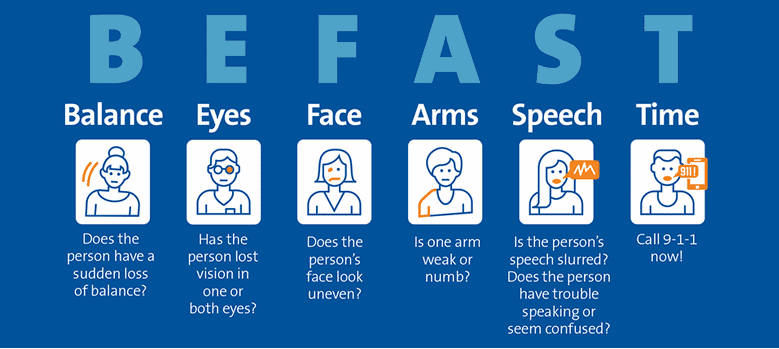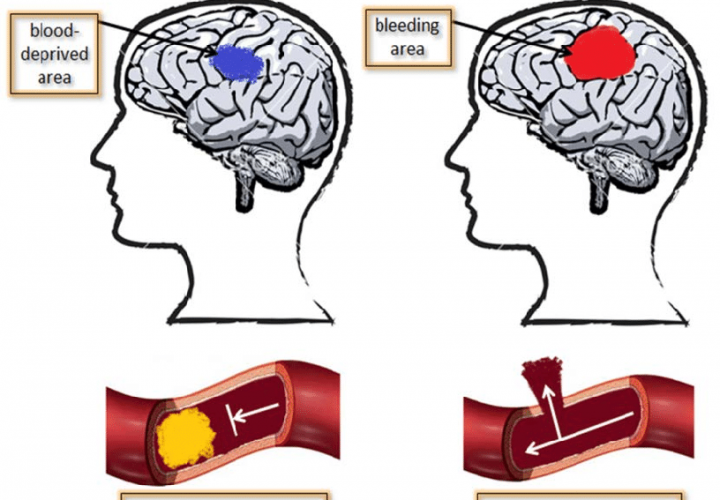May is considered National Stroke Awareness month. A stroke is a serious medical emergency that happens when there is something that affects blood supply to parts of the brain, either a blockage or a burst vessel. It can cause damage to parts of the brain which can lead to lasting long-term disability or death. It is important to be knowledgeable in stroke awareness to be able to prevent your likelihood of stroke or someone else’s. Also, it is important to know the signs and symptoms of a stroke to know when to take action. Stroke is considered to be the 5th leading cause of death in the United States. It also is one of the main causes of disability.
Risk factors of stroke
Risk factors are factors that may have an influence on your chances of having a stroke. There are some that are modifiable, meaning that they can be changed through lifestyle changes, or non-modifiable.
Risk factors for stroke include:
Previous history of stroke or transient ischemic attack. Transient ischemic attacks have similar development as strokes, but lasts less than 24 hours. However, it is still considered a medical emergency.
High blood pressure
High cholesterol
Heart disease
Diabetes
Unhealthy diet
Lack of physical activity
Obesity
Too much alcohol use
Smoking
Age. While the risk of stroke increases with age, there is a surprisingly shocking trend of strokes occurring at younger ages. Even as young as late 20s. This is thought to be influenced by today’s fast-paced lifestyle.
Family history of stroke
Sex. Stroke is more common in women than men. Women of all ages are more likely than men to die from stroke.
Lastly, African Americans, Hispanics, American Indians, and Alaska Natives may be more likely to have a stroke than non-Hispanic whites or Asians.
Signs and Symptoms
If you are having a stroke, it is important to recognize the signs and symptoms quickly, as it is a life-threatening emergency. Time lost is brain lost. One way to remember the signs and symptoms of stroke is to remember the acronym B.E. F. A. S. T.
B: balance- sudden loss of balance
E: eyes- has the person lost vision in one or both of their eyes?

F: face- does the person’s face look even? Is there any droopiness?
A: Arms- is one arm weak or numb?
S: Speech- is the person’s speech slurred? Do they seem confused or have trouble speaking?
T: Time- call 911 now!
What to do if you think you are having a stroke
If you or your loved one think you are having a stroke, seek help IMMEDIATELY AND CALL 911. The faster the person can get to the emergency room, the higher chance of better outcomes that person will have.
Stroke prevention
You can help prevent stroke by making healthy lifestyle choices:
Healthy diet
Eating foods low in saturated fats, trans fat, and cholesterol.
Limiting salt intake
Healthy weight
Being overweight or obese can increase your risks of stroke. You can use a body mass index calculator to determine your range
Physical activity
Exercise can help lower your blood pressure levels, maintain a healthy weight, and lower your cholesterol
For adults, it is recommended to complete 2 hours and 30 minutes of moderate intensity aerobic exercise (such as a brisk walk).
No smoking
Limit alcohol intake
Check cholesterol levels
Your physician should test your cholesterol levels at least once every five years.
Control Blood pressure
Because elevated blood pressure has no symptoms, it needs to be regularly checked. It can be done at the physician’s office, the pharmacy, and even at home with over the counter monitors.
Control diabetes
Treat heart disease
Take your medicine
Work and communicate with your healthcare team
If you have any concerns or questions about your risk for stroke, please talk to your physician. Or any other medical professional to get you the right resources you need.

